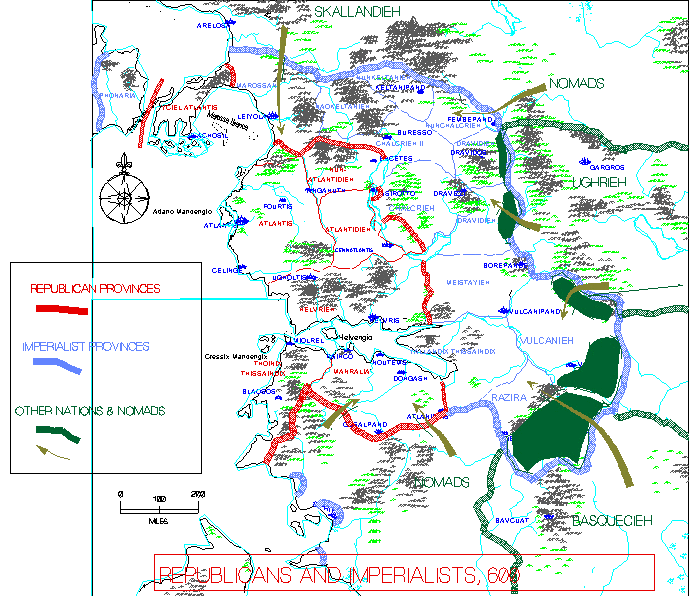|
Home Page
Discovery of Atlantis
First Empire-(1) to 261
Second Empire- (1) 361 - 409 |
|
ATLAN CER¤EH III: SAINDATEYONIX E CER¤UNIX REPUBLICANS AND IMPERIALISTS 591 - 648
Sunset over a landscape with lakes in the north of the Empire
1 : The Establishment of the Republic, 591 ľ 610 THE EMPIRE SPLIT BETWEEN REPUBLICANS AND IMPERIALISTS After the execution of the Emperor Crehonerex in 591, the Republicans in power in Atlantis knew, and exulted in the fact that they had burnt their boats. There could be no going back now - it was all or nothing, the Republic or death. Pranonni, the Leader of the Council, now stretched every nerve to organise the Provinces under Republican control, and all their inhabitants to achieve victory over the Imperialists on the battlefield, and the establishment of a true Republican system of government. Between 591 and 592, the Republican armies advanced steadily eastwards through Chalcr´eh I, conquering nearly all the Province. But in the end, the Imperialists regained their morale, and with superior numbers and larger, heavier forces pressed the Republicans back westwards later in 592 and 593. The Republicans found that the advantages that their lighter, more mobile, and more enthusiastic forces had over the demoralised Imperialists in the earlier years, was of less avail to them now, as the battles became more in the way of slugging matches, in which numbers, weight and experience told most. The Republicans fell back to some earthworks and small fortifications, which had been built years earlier to protect Cennatlantis from an attack from the east. The Imperialists were unable to progress any further, and in early 593 began to settle themselves in entrenched camps opposite their enemy, a mile or so to the east. Fighting continued in other Provinces of the Empire, however. Between Lakes Chalcris and Oncia, the Republicans held on to the fortress of Gasirotto, and also Encetes to the north-west of Lake Chalcris. In the north of the Empire, several Provincial Governors had tried to remain neutral in the conflict, maintaining a vague loyalty to the Imperialist government, but without committing troops to fight the Republicans. The Emperor Norro (formerly General Lingon of the Imperialists) now reasserted his control. In 593 he replaced the Governor of Nunchalcr´eh and occupied it with loyal troops. He also pressurised Naokeltan´eh, but was forced to fight for this Province, as Republican troops had occupied much of the west of it. By 595, the whole Province was in Imperialist hands, as, after another year, was the north of Nundatlantid´eh, as far as the Decanda Runix (mountains). By 599, after years of campaigning, Marossan also fell to the Imperialists, leaving Yciel Atlantis perilously isolated as a republican outpost between Imperialist Marossan and Phoneria. In the south, Manralia was gained completely for the Republicans after some more fighting, but the Province of Th. Thiss. was split north/south between the two sides, Finally, in Meistay´eh, the Republicans advanced from Helvr´eh as far as the rivers Burtounna and Helvenslepp. After this, there was little more serious fighting for at least a decade. Both sides protected their lines with entrenchments and fortifications, and carried out occasional manoeuvres to take a particular position which might give their side an advantage, or distract the enemy from its own plans. Usually such a move would be countered by a parallel stroke by the other side somewhere else on the front, and rather as in a game of chess, this ended the campaign, often without any serious fighting. In fact this suited both sides at least until around 610: the Republicans wanted a peaceful co-existence in order to firmly establish republicanism in the west, while the Imperialists required stability to prevent their state fragmenting and to ward off increasing attacks from barbarians and other states. THE CONSTITUTION OF THE REPUBLIC "Ian teheans siurg theh atlanan sainateyun" "Now we shall begin the building of the Atlantean Republic." (Pranonni, 591) Note that Pranonni was Chalcran and proud of it, and during his time in power, he tried to revive the Chalcran language, and make it of equal standing with Atlantean in the government. He regularly used it for his speeches, and the original statement above was made in Chalcran, viz: "Ian siloggiranni tech atlane sarinalle." Until 594, Pranonni remained Leader of the Council, and the radical and religious party ruled the Republic. In 591, immediately following the execution of Crehonerex, a new constitution for the Republic had been drawn up and agreed by Gorzen Proinen, a well-known female politician, and Giesti, who would become Honorary Leader of the Republic, as it was now called, after the fall of Pranonni in 594. The constitution was much more democratic than ever before in Atlantis. The republican Empire was governed by the Inner Council, members of which were elected by the Council of Government, which itself was elected by local, district and provincial assemblies. The Inner Council also appointed twelve "Atlantean Leaders", five of whom were the most senior, and one of whom was supreme, as the Leader of the Republic. As a group, these Leaders guarded the Republic and supervised the constitution and the law. The five senior Leaders were responsible for the Provinces, the Armed Forces, Finance, Foreign Affairs, and Home Affairs (the latter being the responsibility of the Leader of the Republic himself). The executive arm of government, including the civil service, were chosen from the higher assemblies and the Council, with the heads being appointed by the Leaders. The army was under the direct control of an Atlantean Leader. The constitution aimed to allow all citizens complete freedom of thought, action and belief, and the equality of all before the law. The old Class system was completely abolished in 592, and all the practices and beliefs of the old elite of the Second Empire were discouraged or actively abolished. The liberal side to this republican government was most in evidence before 591 and between 595 and 600. While Pranonni was in control, especially after 591, the Council was dominated by a very radical and religious group. These enforced their views on the country. They placed a priority on fighting the war, and also abolishing all traces of the old Imperialist regime. All aspects were affected : the State Religion was discouraged, in favour of the republicans' own religious beliefs. All art-forms of the old days were disapproved of, especially esoteric art and also the more traditional art-forms of the Empire - Total Works of Art, landscape gardening, dramatic landscapes and wargame landscapes - all ceased by 600. A number of artists of the old era were killed in this period. Buomusse, a great writer of hermetic poetry and prose, and an ardent Imperialist was killed in 589. Giestizzi, a Chalcran composer of hermetic music, was executed for refusing to write music that suited his Republican masters in 608. Only popular and nationalistic works of art were encouraged. The most notable feature of the period between 587 and 600 was the persecution and expulsion of all the Class1 and 2 big landowners in Republican territories. Attitudes to Class 3s, the lowest level of the old nobility varied over the years. The more extreme religious Republicans, who were themselves of Class 4 origin, tended to persecute them, but the less bigoted politicians, who were often of Class 3 background themselves, and took power after 594, preferred to leave them alone. After 590, all the privileges of the old aristocracy were abolished. Everyone was encouraged to own some land, and the noble landowners still living in the Republic were attacked, and either killed or driven off their property after 590. The great Palaces of the Emperors in Atlantis and Cennatlantis were vandalised and taken over by the State, while Thildo's hated Palace in Gentis was completely demolished. Many of the monuments of the Emperors were also pulled down, though sometimes they were simply replaced by Republican statues. A more tolerant regime came in after 594, but then after 606, persecution set in again, and any remaining large or even medium-sized landowners were expelled. Land thus gained was redistributed to poorer people. THE OVERTHROW OF PRANONNI AND "RELIGIOUS REPUBLICANISM". As the war between the two sides died down by 594, the more moderate party, which had started the Revolution, sought to regain power again from Pranonni and his religious extremists. Although they were very militantly opposed to the Imperialists and the Class 1 and 2 landowners within their reach, Pranonni's group made no real attempt to purge the government of these moderates - unlike Robespierre and the extremists in the French Revolution in 1793-4. As a result, Giesti and Fembel were still able, along with younger men like Tuaingeyu, to organise a coup against Pranonni. In March 594, this group, which called itself the "constitutionalists", overthrew Pranonni, and ousted him from his position as Leader, and from republican government. The coup was bloodless, and Pranonni was left to retire into private life - as was hoped. But he, with friends and a group of soldiers, then tried to overthrow the new government in a far from bloodless coup in June. He failed, however, was imprisoned, tried and executed later that year. He was succeeded as Leader by Tuaingeyu. However he did not stay in this post for long. The execution of Pranonni and some of his confederates in September earned him the bitter hatred of the religious party. In October one of them walked up to him in the Council chamber and calmly stabbed him to death. He was succeeded as Leader by Giesti, until 596. THE IMPERIALISTS UNDER PRESSURE While the Republic was thus becoming firmly established in the heartland of the old Empire, the Provinces which still looked to the Emperor were becoming subject to an ever increasing strain. On the borders, old enemies were showing themselves again, keen to take advantage of the weakened state of the Empire. The Basquecs resumed war after 594, and overran half of Razira Province by 597. The rest had fallen by 606, and then they invaded Vulcania, and joined local tribes and pirates in attacking Atlantean ships in the Eriphicko or Southern Sea. Other tribes in the south, previously friendly or allied to Atlantis, raided the south of Th. Thiss. and the southern Atlantean colonies. The Ughans also broke the peace after 599, crossed the river Gestes, and during the next ten years occupied territory on the west bank of the river, and even started moving settlers in there. In 596, a group of south-eastern Provinces - Vulcan´eh, Razira and Yall. Thiss. refused to recognise Norro as Emperor any more. Their Governors did not wish to continue sending their armies north to fight the Republicans at the behest of the Emperor in Atlandravizzi (the Imperialist capital since the loss of Cennatlantis ). Their priority was the defence of their Provinces against the Basquecs; and they created their own Emperor, Yeasor, based at first in Ceriultis in Yall. Thiss. There was no serious fighting between the two Imperialist camps at this stage, however, after some early attacks from Meistay´eh across the river Gestes were repelled. Yeasor was captured by the Basquecs when defending Razira in 604, and his place was taken by General Proinen, who did not even bother to style himself Emperor.
To read the next part of this history, click on (2) 600-629 |


